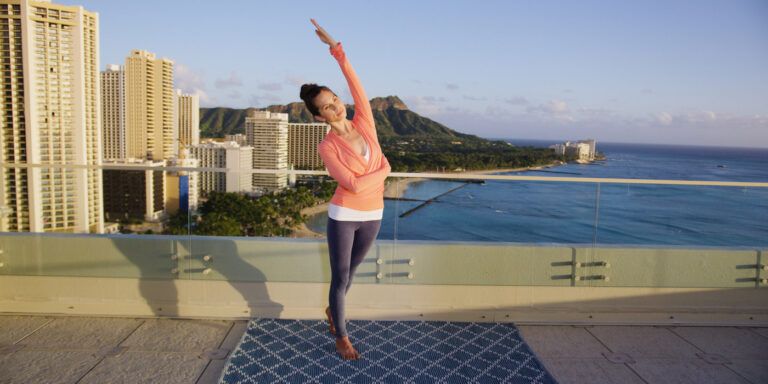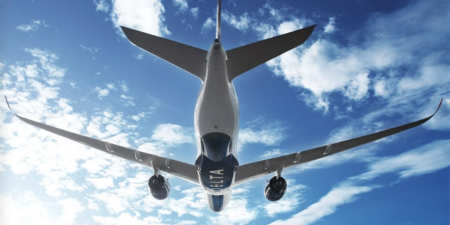Moving benefits everyone, no matter what your age, gender, physical condition or activity level. Our bodies are made to move; we are at our best when we are active. Physical mobility brings many benefits, including strengthening muscles, increasing flexibility, lowering blood pressure, building the immune system and improving joint health and cardiorespiratory endurance.
Common physical issues associated with sitting for hours on a plane without moving include experiencing stiff joints (mainly hips, knees and shoulders); sore muscles (particularly the neck, shoulder, hip flexors and lower back); and poor circulation (symptoms include fatigue, numbness or tingling in the hands or feet and/or cold hands, feet, legs and ears). Deep vein thrombosis, the formation of blood clots (usually in the legs), is a serious concern. You can get more information about DVT from your doctor.
Pre-flight routine
It’s imperative to keep our bodies mobile and aligned to ease discomfort, maintain optimal range of motion and sustain the healthy functioning of all systems. It’s not enough to just strengthen or just stretch our bodies; we need a balance of both through frequent, consistent, varied and mindful movement.
Flying to or from Hawaii, you’ll usually be in a fixed sitting position for at least five hours. From the moment you sit and more so as time passes, circulation decreases and joints and muscles stiffen. Take advantage of the space you have in the boarding area to stand and do full ranges of motion for your feet, knees, hips, spine, shoulders and neck.
A simple inflight workout
March in place: Stand tall with your feet parallel. Lightly hold a seatback if you need extra support. Keep your hips and torso stable while you alternate raising one knee at a time to hip height. Move at a controlled pace. Continue for 30 seconds.
Heel raises: Take the stance above. Slowly raise your heels off the floor. Hold for 5 to 10 seconds, then slowly lower your heels to the floor. Repeat 10 times.
Standing twist: Stand with your legs parallel and a foot and a half apart. Twist to the left and right, initiating it from your hips. Relax your arms and let them swing naturally with the twist, allowing the spine to move without strain. Continue for 30 seconds.
Combination: These movements can be done individually or combined. Repeat 1 to 3 times.
Hold stretches about 30 seconds each 1 or 2 times. Be sure to breathe throughout the stretch. You’ll get the most rewards from stretches when you can support them with strengthening from the opposite side. For example, to get longer-lasting benefits from a stretch like a right lunge (right leg is bent and left leg is straight back), which helps stretch the front of your left hip, gently contract your left glute.
Here’s how those movements look. Guests onboard Hawaiian Airlines’ transpacific flights now have access to health and wellness video content produced exclusively by the airline for its in-flight programming catalog. The Ola Pono (Live Well) series stars Honolulu movement specialist, Wainani Arnold
Where can I do standing movements?
When the seat belt sign is turned off, it’s great to walk around the cabin to get your blood flowing. As you stand at your seat or in the aisle, you can perform heel raises. While you’re waiting to use the restroom, you can march in place, gently arch your spine, and do standing twists.
When is the best time to do these exercises?
Every chance you get — at home, at your hotel, before and after you check in and go through the security line. While you’re in the boarding area, just before you get on the plane, is the optimal time to give your body the tender loving care it needs before going on a long flight.
You should consciously move, whether it’s in your seat or standing, every 20 minutes for at least 10 minutes. The air in airplane cabins is dry, so before you move, make sure you are well hydrated (you should keep well hydrated throughout the flight). Dehydration can lead to fatigue, dizziness, headache and muscle cramps. Drinking water is best. Excessive alcohol consumption causes dehydration, which affects all your tissues.

Are there a seated alternative?
Absolutely! With static movement (a held position), the joint angle and muscle length don’t change. The beauty of this in the aircraft is that it looks like you’re not doing anything, yet it is very effective. Even small movements are doable in a limited space; these could be as simple as cinching and releasing your waist; squeezing and releasing your glutes; and sitting tall and straight, which facilitates breathing and organ function. You can also raise both arms over your head; gently roll your shoulders forward, up, back and down; raise your feet and rotate them in circles, both clockwise and counterclockwise; and move your neck in all directions (look up, down, left, right, tilt right, tilt left). Or try these: Alternate lifting your knees; lift your heels, keeping your toes on the floor; and lift your toes, keeping your heels on the floor.
Should I continue to move after my flight?
You’ve been in a restricted space for several hours, so it’s important to return your body to a fully functioning mode. If you can, walk to the baggage claim area instead of taking a shuttle. That will warm and loosen your muscles, reducing the chance of injury to your back and shoulders and enabling you to better handle your luggage.
As soon as you disembark, take advantage of every opportunity you have to move. In addition to walking to baggage claim, do simple exercises while you’re waiting for your luggage, picking up your rental car, checking in to your hotel and getting settled in your room. Keep frequent, consistent, varied and mindful stretches and movements top of mind.
What post-flight movements do you recommend?
These are all great and easy to do: Walk with long strides; twist to the right and left while standing; swing your arms and legs like a pendulum; roll your shoulders front to back and back to front; and do full body stretches (anchor your feet on the ground, then reach your arms straight overhead). The calf stretch is also beneficial, albeit more involved. With one leg forward with your knee bent and the other leg two feet behind and straight, press your back leg’s heel into the floor to lengthen the calf muscle. Repeat on the other side. Whatever movements you do, it’s important to remember that you’ve been in a cramped position longer than normal, so to avoid hurting yourself, you should perform all of them slowly and gently.
Try it yourself. This video featuring Wainani Arnold is from the inflight wellness section of the Hawaiian Airlines IFE catalog:
Should I continue exercising throughout my trip?
Definitely! Whether you’re traveling for business or pleasure, it’ll be more enjoyable if your body is functioning optimally and is free from injury. In fact, don’t wait until you travel; make exercise a part of your regular routine! Take 10 to 30 minutes at least once every day to do something good for your body. Hike, swim, walk on the beach do simple stretches and movements. Before you know it, you will have a healthy habit that will contribute to your overall well-being for years to come.

About Wainani Arnold
Wainani Arnold, founder of Wainani Wellness Center (www.wainaniwellness.com), is a movement specialist, choreographer and performer with 15 years of experience teaching yoga, Pilates, Gyrotonic and dance. She is a 2000 graduate of Kamehameha Schools and holds a bachelor of fine arts degree in dance teaching/performance from Chapman University in Orange, California.
Arnold has extensive training in many dance genres, including hula, jazz, hip-hop, modern, ballet, ballroom and aerial dancing. She has performed professionally throughout Hawaii, the United States, Europe and Asia. Her approach to movement is holistic; she believes in training the body through the balance of opposites — stretch/strength, slow/quick, deep/superficial, focus/fun — to help the body reach optimum conditioning.
Her goal, she says, is “to help others find joy, inspiration, harmony, balance, peace and healing through creative and therapeutic movement.”





